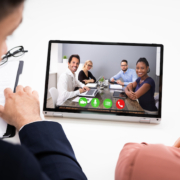How’s your hybrid planning model developing?
There’s a lot of talk at the moment about hybrid planning models, and the truth is that they probably mean different things to different advisers. So, here’s my tuppence worth on them…
To my mind, a hybrid planning model is one where the best traditional financial planning practices are supplemented by a digital proposition that further adds value to the adviser / client relationship and ultimately supports the achievement of better client outcomes. Here are some elements that will go a long way to creating an effective, hybrid financial planning model.
Remote as well as in-person meetings
This is the obvious first step, and a straightforward one with the experience of the last two years. Advisers now recognise that every interaction with a client doesn’t need to be a physical, in-person meeting. Instead, a client who previously may have been met in person three of four times a year, now might only require a single in-person meeting, supplemented by several remote meetings. This saves valuable time for everyone and facilitates more flexibility around meetings – it’s a lot easier to “jump on to a Zoom call” than having to “jump into the car” and then sit in traffic…
Online data gathering
Many advisers are now having more effective meetings with clients, by utilising a range of tools that can be deployed before a planning meeting. Rather than starting a planning meeting with a blank page, clients are requested to complete some or all of an online factfind, a risk profiling questionnaire and an expenditure questionnaire in advance of the meeting. These are enabling better preparation for the meeting and a much richer client experience. A by-product of requesting this information is that advisers find that it removes “tyre kickers” – clients who give the time to providing this information are committed to the process.
Online supporting material
I’m aware of some advisers who have gone to significant efforts to provide excellent guidance to clients across a broad range of technical subjects. Their thinking is that a better-informed client results in more engaging and valuable conversations at the actual meetings. This in no way negates the need for or value of the advice ultimately given, as a technical guide on a particular subject cannot take account of a client’s own individual circumstances or cannot consider the full range of appropriate solutions to be considered. Apart from the value clients get from such whitepapers or expert guides, this supporting material demonstrates a firm’s commitment to adding value and shows confidence in their expertise.
Online collaborative tools
We’ve also seen the emergence of tools that support collaboration at planning meetings. Good planning meetings are never lectures, with the adviser as the teacher! Instead they are two parties considering together a range of objectives, strategies and approaches, with “What If” questions frequently arising and being considered. Future cashflow planning software is very visual and really supports collaboration and discussion at meetings. Indeed with some of the tools, clients can use the tool and consider scenarios themselves, outside the confines of a meeting.
Leveraging the wider team
With this greater level of engagement and interaction, this does not have to mean that the adviser must be involved at every single touchpoint. The opportunity now exists to move some of the interactions towards a paraplanner or support person, who can work with the client through some of the interactions. Broadening the relationship beyond a single point of contact – the adviser – makes for a better client experience, removes risk in the business of an adviser leaving or being ill… and spreads the workload.
So, are you up for this new planning model? It adds a lot of value to both your business and your clients, but like anything, there is a cost involved. The challenge in this case is your capability to deliver effective remote meetings, and your ability to really understand and fully utilise the technology that you are using. For example, your hybrid model will start falling apart if you get tripped up every time you try to change something in your client’s future cashflow plan. So, the cost is a time commitment from you to fully understand and be confident in your use of the financial planning tools that you are deploying.
The benefits though really outweigh these costs. Are you ready to roll out your hybrid proposition?



